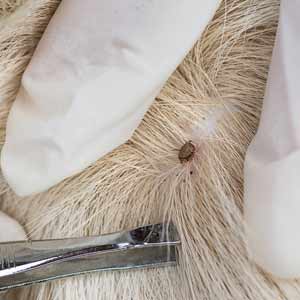Each new season and new environment bring important considerations when you are a pet owner. While keeping your dog healthy is a priority for all pet parents, sometimes this task is more than meets the eye. Ticks can transmit Lyme and other diseases to your pooch and can be tricky to spot. These creepy crawlers become even more common during the summer months or in climates that remain warm year-round. If you’re enjoying the great outdoors with your canine companion, know what to look for, what the risks are for tick-borne diseases, how to treat a tick bite, and how to prevent these pests.
Table of contents
- Can ticks make your dog sick?
- Types of ticks
- When is tick season?
- Where do ticks live out in the wild?
- Where do ticks hide on your dog?
- What to do when your dog gets a tick
- How can you prevent your dog from getting a tick-borne disease?
Can ticks make your dog sick?
Ticks are efficient carriers of disease, according to veterinary experts at VCA Animal Hospitals. These parasites latch onto and feed on the blood of their host, potentially for a significant amount of time before being noticed. Just like humans and other mammals, dogs are susceptible to tick-borne diseases. Depending on the type of bug that your pup attracted, transmitted diseases can include:
- Lyme disease – An infectious disease carried by the Deer or Black-Legged tick, Lyme disease has typically been associated in the Northeast and upper Midwest areas of the United States, although they can also be found on the west coast (Washington, Oregon, and California), as well as along the East coast down to Florida.
Signs of Lyme disease may include fever, lameness, limping, joint pain/swelling, enlargement of lymph nodes, and lethargy. Lyme disease can progress to kidney disease, which can become fatal. The parasite must be attached to its host for about 36-48 hours for transmission, and signs of illness occur about two to five months after a tick bite, yet many dogs will carry Lyme disease their entire life without any clinical signs.
- Rocky Mountain Spotted Fever – Rocky Mountain Spotted Fever is one of the more commonly known tick-borne diseases to affect dogs. It is carried by the American Dog Tick. This disease has been found in much of North, South, and Central America. Signs include fever, poor appetite, swollen lymph nodes, low platelets, and joint pain. Neurological signs such as wobbliness can also occur.
- Ehrlichiosis – Canine Ehrlichiosis, or Ehrlichia, is found throughout the world. It is caused by several types of ticks: Brown Dog, Lone Star, and American Dog. Signs include fever, poor appetite, and low blood platelets. This is often noted by nose bleeding or other signs of bruising or anemia. Signs usually start within three weeks after the bite of an infected parasite. Dogs diagnosed and treated promptly can have a good prognosis. Those who go on to the chronic phase have more difficulty recovering.
- Anaplasmosis – Caused by a bacterium carried by the Black-Legged tick, Anaplasma can be seen worldwide. Signs of Anaplasma are similar to those of Lyme disease. Though dogs with Anaplasma can carry this disease without any clinical signs, when they arise it’s often seen as low blood platelets that cause bleeding disorders, warns VCA.
- Babesiosis – A primary concern associated with Babesiosis is “hemolysis,“ or the breaking down of red blood cells. Look for lethargy, pale gums, dark-colored urine, and jaundice, in which a dog’s skin and or eyes can become yellow or orange in color.
Symptoms of tick bites

Signs of tick-borne diseases can vary depending on the infection, but not all bites result in infection. If you suspect your dog may have been bitten by a tick, you may notice red and or inflamed skin. Your pup may be licking, chewing, itching, or head shaking. Unfortunately, itchy skin can lead to secondary issues such as hot spots when a pup suffers from incessant scratching.
Types of ticks
There are several different types of ticks that can deliver potentially dangerous bites to your canine companion. Common types to look out for include:
- American Dog Tick – Adult American Dog ticks can be identified as chestnut brown with white spots or streaks on their backs. Engorged females become slate gray and may expand to a half inch in length. Larvae and nymphs feed mostly on small rodents, while adults feed on dogs, cattle, other animals, and humans. Adult American Dog ticks can live for up to two years without food and can transmit Ehrlichiosis.
These bugs are widely distributed throughout the Midwest, the Pacific Northwest, and eastern United States, as well as east of Saskatchewan in Canada. American Dog ticks are most often encountered in grassy areas or low vegetation near roads, paths, trails, and recreational areas. Although present all year round, these pests are most prevalent in the spring.
- Lone Star Tick – Adult lone star ticks are various shades of brown or tan. The female has a single silvery-white spot on their back and males have scattered white spots. After feeding, females may be as long as a half inch. Like American Dog ticks, larvae and nymph Lone Star ticks feed on small wild animals, birds, and rodents. Adults feed on larger animals such as dogs and cattle. Lone Star ticks of all ages will bite dogs and humans. This makes them easier or more difficult to spot depending on their size.
Regionally, Lone Star ticks can be found in the Midwest, eastern, and southeastern, and United States. According to the American Kennel Club (AKC), the range of this pest may be expanding with the re-introduction and increased populations of white-tailed deer in many areas of the eastern US. These parasites live in wooded and brushy areas. They are most numerous in the underbrush along creeks and river bottoms, and near animal resting places. Lone Star ticks are present throughout the year, but peak populations may occur from March to July.
- Deer or black-legged tick – These parasites have flat, orangish-brown bodies that become darker in color when feeding on a host. All three active stages of this pest will feed on a variety of hosts including dogs and people.
These ticks are usually found in wooded areas along trails. They are distributed throughout the Midwest and eastern US, as well as throughout Canada, with the highest proportion in Ontario. While larvae and nymphs are active in the spring and early summer, adult Deer ticks may be active in both the spring and fall. These bugs are responsible for transmitting Lyme disease and Ehrlichiosis to dogs as well as people.
- Brown Dog tick – Adult Brown Dog ticks, or Kennel ticks, are typically reddish-brown and attach around the ears or between the toes of a dog to feed. According to VCA, after feeding, a female may engorge to a half inch long. She then drops off the dog and crawls into a hiding place where she may lay as many as 5,000 eggs. This tick feeds on dogs, but rarely bites people.
This pest is found throughout most of the United States and Canada and can also transmit Ehrlichiosis. Unlike the other species, its life cycle allows it to survive and develop indoors which means it can establish itself in colder climates. The brown dog tick is found primarily in kennels or homes with dogs. It may be found hiding in cracks, behind radiators, under rugs and furniture, and on draperies and walls. This parasite is tropical in origin and does not survive long, cold winters outdoors.
When is tick season?
Ticks can appear year-round but are even more common during the months with warmer temperatures. Some species can be active on winter days if the ground temperatures are above 32 °F. Tick seasons will vary depending on region and types.
Where do ticks live out in the wild?
Ticks can be found anywhere outside, but are more likely to live in heavily woody and grassy areas. They wait for host animals on the tips of grasses and shrubs. When the plant is brushed by a moving animal or person, the tick quickly lets go of the vegetation and climbs onto the host in a process called questing.
These pests can only crawl—they cannot jump or fly. Whenever you visit the park, go on a hike, or walk through the woods, be sure to check both of your bodies for ticks. They may have latched on while you were out in nature.
Where do ticks hide on your dog?
Because ticks are small and latch onto your dog’s skin, they can often be mistaken for other bumps and skin tags. While all dogs can get ticks, these little pests are more difficult to spot on long-haired and dark-coated pups. Understandably, it’s easier for these parasites to be missed under layers of fur when petting or checking your dog.
Ticks gravitate to hiding places on your canine companion where they are least likely to be found. They also like dark, moist, and warm areas where they can set up shop. Ticks can be found anywhere on a dog’s body, but according to AKC, some common areas to check include:
- Head and ears
- Eyes
- Groin
- Toes
- Tail
- Neck/collar
- Armpits under your pup’s front legs

When giving your pooch a full-body tick check, make sure you get all the way through their coat down to their skin, where these parasites really want to be. You can use a lint roller immediately after outdoor play to pick up any loose dirt or debris that your pup may have picked up outside. For dogs with longer coats, a hair dryer can be a great tool in pushing back fur and examining your pup’s skin.
What to do when your dog gets a tick
The longer a tick can feed on your dog, the greater chances your pup will have of contracting a tick-borne disease, warns AKC. With this, immediate tick removal is critical. As previously mentioned, not all tick bites result in disease transmission and don’t require a veterinarian visit, but consulting your vet is never a bad idea—if you feel more comfortable, you can have your vet remove and examine a tick bite.

VCA Animal Hospitals notes that you should wear gloves or use a paper towel to protect yourself while removing a tick from your dog. Just like removing ticks from humans, you should use tweezers to grasp the pest as close to the skin surface as possible and pull straight up and out. Make sure you remove the entire tick, as it’s possible for ticks to continue to transmit disease if their body has been detached from their head. Note that it may take a minute or two of constant pressure with the grasp and steady, slow pulling to get the tick to release.
Never just rip it off as this will likely lead to the head remaining in your pet.
Once a tick is removed, thoroughly disinfect the bite site. You can either have your vet test the pest for disease, or properly trap the tick and either keep it in a safe place for later reference or dispose of it. Ticks are very hardy and can reattach if not disposed of properly! You can flush the removed tick down the toilet, drown it in a bowl of rubbing alcohol, or wrap it in tape to ensure it does not latch onto anything or anyone else. The latter two methods can also be used to safely preserve the tick if you wish to identify and or test it for disease later.
Check the bite site throughout the following days to ensure there is not further irritation or infection. Some redness and itching are possible and not necessarily cause for concern. If these symptoms become worse, if you observe any inflammation or oozing, or if your pup is in pain, however, consult your veterinarian.
Treatment for specific tick-borne diseases such as Lyme typically includes antibiotics prescribed by a veterinarian following a positive lab test to confirm your dog is indeed infected. VCA Animal Hospitals warns that an early test can be falsely negative if the dog is infected, but has not yet formed antibodies. For this reason, it’s recommended that pups are tested only after four weeks following a tick bite. If your dog initially tests negative but continues to show symptoms after a month or two, consult your veterinarian.
How can you prevent your dog from getting a tick-borne disease?
There are a handful of things dog owners can do to prevent their pup from contracting tick-borne diseases. First, it’s important all dog parents understand the prominence of ticks where they live. All locations and environments will differ and will inform your prevention strategies.
Giving your pup a thorough, full-body tick check immediately after returning inside from outdoor activity is key to early detection and disease prevention. According to AKC, pet parents can also create a dog-friendly outdoor space that is unfavorable to pests like ticks. To do this, AKC encourages keeping the lawn mowed short, trimming tree limbs and shrubs, using cedar mulch, and treating your yard with anti-pest sprays.
There are many different types of tick preventatives on the market. You will often see these products marketed as preventing both fleas and ticks. Medications can be over the counter, such as Frontline Plus, or prescription, such as Bravecto, Simparica, and NexGard. Treatments can be administered orally as pills or chews, or topically as oils, shampoos, or sprays. You can also utilize apparel options, including collars, vests, and bandanas. Talk to your veterinarian about the best prevention methods for your pet.
Finally, there are also canine vaccines available that prevent the transmission of bacteria associated with Lyme disease and or reduce the severity of illness in the event your dog does contract Lyme. According to the Indiana Veterinary Medical Association, these vaccines have unknown efficacy and pet owners should not assume that their dog is immune to Lyme once vaccinated. As bacterial vaccines their longevity is shorter than most vaccines given to your dog and should be boostered regularly for best protection. These vaccines are typically only recommended for dogs living in areas where Lyme is a known issue.
Any health or medical information in ElleVet blogs is from a variety of public and reputable sources. This information is intended as an education resource only and is not a substitute for expert professional care.
-
 ElleVet Hemp CBD + CBDA Soft Chews$89.00 – $99.00 — or subscribe and save 15%
ElleVet Hemp CBD + CBDA Soft Chews$89.00 – $99.00 — or subscribe and save 15% -
 ElleVet Hemp CBD + CBDA Soft Gels$49.00 – $159.00 — or subscribe and save 15%
ElleVet Hemp CBD + CBDA Soft Gels$49.00 – $159.00 — or subscribe and save 15% -
 ElleVet Hemp CBD + CBDA Oil For Dogs$79.00 – $249.00 — or subscribe and save 15%
ElleVet Hemp CBD + CBDA Oil For Dogs$79.00 – $249.00 — or subscribe and save 15%









